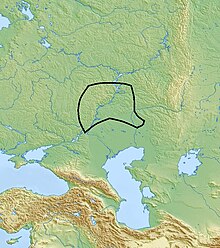
Back حضارة بولتافكا Arabic Cultura de Poltavka Catalan Poltavka-Kultur German Cultura poltavka Spanish Culture de Poltavka French Cultura di Poltavka Italian Cultur Poltavca LFN Poltavkacultuur Dutch Полтавкинская культура Russian Полтавкинська культура Ukrainian
 | |
| Geographical range | Russia, Kazakhstan |
|---|---|
| Period | Bronze Age |
| Dates | c. 2800 BCE – 2100 BCE |
| Preceded by | Yamnaya culture |
| Followed by | Potapovka culture, Abashevo culture, Sintashta culture, Srubnaya culture. |
| Part of a series on |
| Indo-European topics |
|---|
 |
Poltavka culture (Russian: Полтавкинская культура, romanized: Poltavkinskaya kul'tura) was an early to middle Bronze Age archaeological culture which flourished on the Volga-Ural steppe and the forest steppe in 2800—2100 BCE.[1]
The Poltavka culture emerged as an eastern outgrowth of the Yamnaya culture, neighboring the Catacomb culture, another Yamnaya successor, in the west. It has been considered ancestral to later cultures that are identified as Indo-Iranian.[2] The Poltavka culture influenced the later emergence of the Potapovka culture, Abashevo culture, Sintashta culture and Srubnaya culture.
- ^ Kuznetsov & Molchalov 2016, p. 74.
- ^ Nichols, Johanna (January 14, 2021). "The Origin and Dispersal of Uralic: Distributional Typological View". Annual Review of Linguistics. 7 (1): 351–369. doi:10.1146/annurev-linguistics-011619-030405. ISSN 2333-9683.
...the ancestor of Proto-Indo-Iranian had almost certainly been the language of the nomadic pastoral Poltavka culture of the Caspian steppe